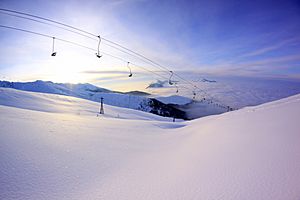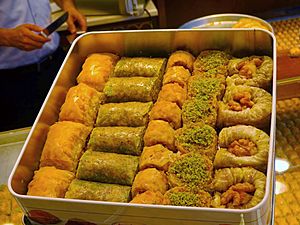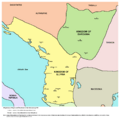Kosovo facts for kids
Quick facts for kids
Republic of Kosovo
|
|
|---|---|
|
|
|
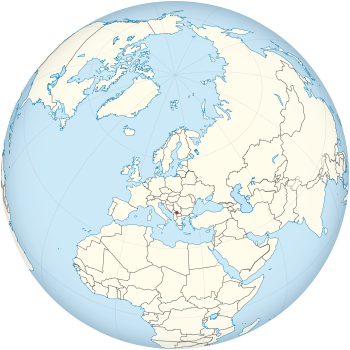
Location of Kosovo in the world
|
|
| Status | Disputed
|
| Capital and largest city
|
Pristina 42°40′N 21°10′E / 42.667°N 21.167°E |
| Government | Unitary parliamentary constitutional republic |
| Legislature | Assembly of Kosovo |
| Area | |
|
• Total
|
10,887 km2 (4,203 sq mi) (171nd) |
|
• Water (%)
|
1.0 |
| Population | |
|
• 2019 estimate
|
1,920,079 |
|
• Density
|
159/km2 (411.8/sq mi) |
| Currency | Euro (€)d (EUR) |
| Time zone | UTC+1 (CET) |
|
• Summer (DST)
|
UTC+2 (CEST) |
| Driving side | right |
Kosovo is a territory located in the Balkans region of Southeastern Europe. It is a place with a long history. Whether it should be considered an independent country is a topic of discussion. Kosovo declared its independence in 2008, but some countries, including Serbia, do not recognize it as fully independent.
Kosovo has been part of many empires and states over time. These include the Roman Empire, Byzantine Empire, Serbian Empire, and Ottoman Empire. In the 20th century, it was part of Yugoslavia. After a conflict in 1999, the United Nations helped manage the territory.
The Assembly of Kosovo declared independence in February 2008. Since then, over 100 countries that are members of the United Nations have recognized Kosovo as an independent state. Serbia still claims Kosovo as its own territory.
Kosovo shares borders with Serbia to the north and east. To the south is North Macedonia. To the west are Albania and Montenegro. The capital and largest city is Pristina. About two million people live in Kosovo. Most people are of Albanian background, but there are also Serbs, especially in the northern part of Kosovo.
Medieval Monuments in Kosovo is a special UNESCO World Heritage Site. It includes four old Serbian Orthodox churches and monasteries. These buildings were founded by the Nemanjić dynasty, an important family in Serbia in the Middle Ages.
Kosovo has a growing economy. It has been getting stronger economically for the past ten years. It is a member of groups like the International Monetary Fund and World Bank.
Contents
Exploring Kosovo: Tourism and Attractions
Kosovo has many beautiful natural places that are great for tourism. Its location in the middle of the Balkan Peninsula makes it a historic crossroads. Kosovo connects Central Europe and Southern Europe to the Adriatic Sea and Black Sea.
The western and southeastern parts of Kosovo are mountainous. These areas are perfect for winter sports like skiing. The Brezovica ski resort in the Šar Mountains is a well-known winter destination.
Kosovo's landscape includes high mountains, clear lakes, deep canyons, and winding rivers. The Brezovica ski resort is easy to reach from Pristina Airport (60 km away) and Skopje International Airport (70 km away). This makes it a good choice for international visitors.
Other exciting places to visit include the capital city, Pristina. You can also explore the historic cities of Prizren, Peć, and Gjakova. Ferizaj and Gjilan are also interesting cities. In 2011, The New York Times even listed Kosovo as one of the top places to visit!
Delicious Kosovan Cuisine
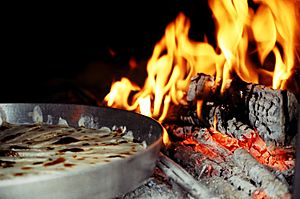
The food in Kosovo is a mix of Albanian and Serbian influences. Food is very important in social life, especially during religious holidays like Christmas, Easter, and Ramadan. For special celebrations, sweet treats like Baklava, Lokum, and Halva are often made. These are enjoyed in almost every home across Kosovo and the Balkans.
Two very traditional Kosovan dishes are Flia and Pite. Flia is made of many layers of thin crepes, usually brushed with cream. Pite are savory pastries filled with cheese, meat, potatoes, or leek. These dishes are often served with vegetables, fruit preserves, honey, and yogurt.
Kosovan food uses a lot of fresh fruits, vegetables, and herbs. Common spices include salt, red pepper, and black pepper. People in Kosovo enjoy many kinds of meat and fish. Popular choices include chicken, beef, kebab, suxhuk, and lamb. Lamb is often eaten for religious events.
Tea is a very popular drink in Kosovo. You can find Albanian-style mountain tea or Russian and Turkish-style black tea. These are served in cafés, restaurants, and homes. Coffee is also a favorite drink, and Kosovo has a strong coffee culture.
Nature's Wonders: Flora and Fauna
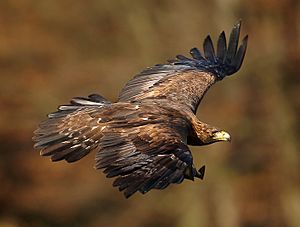
Kosovo is located in Southeastern Europe, which means it has many different kinds of plants and animals. Its biodiversity is protected in two national parks, eleven nature reserves, and over one hundred other protected areas.
The Prokletije National Park and Šar Mountains National Park are very important for plants and animals in Kosovo. The country has more than 1,800 known plant species, and experts believe there could be over 2,500 in total.
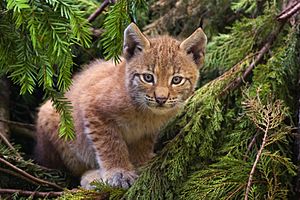
Kosovo is home to a wide variety of animals. The mountains in the west and southeast provide a great home for many rare or endangered animals. These include brown bears, lynxes, wild cats, wolves, foxes, wild goats, roebucks, and deers.
More than 255 types of birds have been seen in Kosovo. Large birds of prey, like the golden eagle, eastern imperial eagle, and lesser kestrel, mostly live in the mountains.
Related pages
Images for kids
-
Goddess on the Throne is an important artifact and a symbol of Pristina.
-
Ruins of Ancient Ulpiana near Pristina.
-
Gračanica Monastery, a UNESCO World Heritage Site.
-
Visoki Dečani Monastery, a UNESCO World Heritage Site.
-
Division of Kosovo vilayet after the Balkan Wars in 1913.
-
German soldiers near Mitrovica, circa 1941.
-
Fadil Hoxha, Vice-President of Socialist Federal Republic of Yugoslavia.
-
Marines setting up a roadblock in Kosovo in 1999.
-
US President Bill Clinton with Albanian children in Kosovo, June 1999.
-
Camp Bondsteel, a main base for the United States Army in Kosovo.
-
The Newborn monument in Pristina, unveiled on Independence Day 2008.
-
Prime Minister of Kosovo Avdullah Hoti with U.S. President Donald Trump and President of Serbia Aleksandar Vučić in 2020.
-
Alpine climate in Pashallora seen from Brezovica.
-
The Academy of Sciences and Arts in Pristina.
-
Majlinda Kelmendi, an Olympic, World, and European champion.
See also
 In Spanish: Kosovo para niños
In Spanish: Kosovo para niños




